|
|
|
Sort Order |
|
|
|
Items / Page
|
|
|
|
|
|
|
| Srl | Item |
| 1 |
ID:
145695
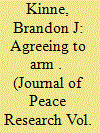

|
|
|
|
|
| Summary/Abstract |
This article assesses the impact of a new form of defense cooperation – formal weapons cooperation agreements, or WCAs – on the global arms trade. WCAs are bilateral framework agreements that establish comprehensive guidelines on the development, production, and exchange of conventional arms. Substantively, WCAs regulate such core areas as procurement and contracting, defense-based research and development, and defense industrial cooperation. These agreements have proliferated dramatically since the mid-1990s. They now number nearly 700, with 30–40 new WCAs signed each year. Newly collected data are used to analyze the effect of WCAs on import and export of conventional weapons. To control for interdependencies in the formation of WCAs, and to account for the mutually endogenous relationship between WCAs and weapons flows, WCAs are modeled as an interdependent network that coevolves with the individual-level arms trade activity of states. The analysis shows that, over the 1995–2010 period, WCAs have significantly increased weapons flows.
|
|
|
|
|
|
|
|
|
|
|
|
|
|
|
|
| 2 |
ID:
145702
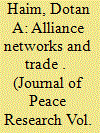

|
|
|
|
|
| Summary/Abstract |
How does the network of international political alliances influence trade flows? Previous work suggests that alliances matter in predicting trade outcomes because governments align trade policies with national security interests and firms take political relations between states into account when assessing risk. However, work to date investigates only the relationship between direct political alliances and trade, which ignores the complexity of international alliance structures. In this article, I argue that states and firms not only consider direct political relationships when shaping international trade, but also focus crucially on indirect alliance relationships. I find that higher levels of trade result when states have more shared alliances and when they are in the same alliance community. Once these indirect relationships are accounted for, the apparent association of dyadic alliances with trade is drastically reduced. Joint membership in an alliance community predicts an increase in trade that is more than twice the increase associated with a dyadic alliance. This effect is magnified when considering highly ‘central’ states in the alliance network. States trade significantly more with central states in their own alliance community and less with central states in other communities.
|
|
|
|
|
|
|
|
|
|
|
|
|
|
|
|
| 3 |
ID:
145693
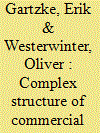

|
|
|
|
|
| Summary/Abstract |
Researchers continue to debate the impact of trade on interstate conflict. While many view trade as pacifying, others argue that dependencies increase friction and the risk of war. We provide a theory that explains how cross-border economic ties alternately enhance or impede international cooperation. Three main factors account for the heterogeneous effects of trade on conflict: interdependence, asymmetry, and multipolarity. Interdependence can act as a substitute for, or as a deterrent to, militarized violence. In the former case, interdependence actually increases more modest non-militarized conflict, while also discouraging militarized disputes. Asymmetry diminishes the conflict-inhibiting effect of trade ties, as dependency cannot simultaneously be used to coerce and to inform. Multilateral trade networks alternately moderate or enhance the bilateral effects of interdependence and asymmetry on interstate peace. Our theory and evidence reveal complex, cross-cutting consequences of economic interdependence on conflict behavior and also demonstrate effects well beyond the dyad, suggesting the need to include extradyadic ties in future theoretical and empirical research studying the commercial peace.
|
|
|
|
|
|
|
|
|
|
|
|
|
|
|
|
| 4 |
ID:
145698


|
|
|
|
|
| Summary/Abstract |
This article applies recent advances in network analysis to highlight a central tension faced by policymakers – balancing the benefits of engaging with the international system and the associated domestic policy costs. International trade rewards certain domestic practices, such as respect for human rights. Enforcing such practices, however, is politically costly and sometimes prohibitive to state leaders who rely on political repression to stay in power. In such cases, domestic elites often resort to an alternative strategy of securing the benefits of international trade – setting up indirect trade channels through intermediary states. These competing incentives are modeled within a single framework using a formal network game in which states form trade-links (direct or indirect) with other states, while simultaneously choosing their optimal level of domestic human rights protections. The model suggests that there may be an inverse relationship between a state’s embeddedness within a network of indirect trade and respect for human rights: indirect trade channels serve as loopholes that allow domestically troubled states to enjoy the benefits of trade without pressure for domestic improvement. The predictions are supported by the results of the empirical analyses of the international trade and repression data (1987–2000), conducted using a coevolutionary actor-oriented longitudinal-network model – a statistical estimator that closely mimics the theoretical model.
|
|
|
|
|
|
|
|
|
|
|
|
|
|
|
|
| 5 |
ID:
145691


|
|
|
|
|
| Summary/Abstract |
We study the effects of shocks – such as major wars that change states’ strategic environments – on alliance networks. This has important implications for the structure of security cooperation networks. We develop an agent-based model (ABM) that: (1) models network evolution processes of security cooperation networks; (2) induces shocks that cause significant changes in agents’ utilities due to shifts in common interests between states; (3) analyzes how networks reorganize in the post-shock period. We derive propositions from the ABM about the relationship between shock attributes and network structure. We compare the results of the ABM to similar shocks that operate on real-world alliance networks. The ABM results with random network data suggest that states that experience dramatic changes in their strategic environment increase network connectivity and consistency. Consequently, post-shock networks become increasingly connected (denser) and consistent (transitive). With a few notable exceptions, these results are corroborated by analysis of alliance network reorganization following shocks. We discuss the theoretical and empirical implications of the results and offer directions for future research on shocks and international networks.
|
|
|
|
|
|
|
|
|
|
|
|
|
|
|
|
| 6 |
ID:
145692


|
|
|
|
|
| Summary/Abstract |
The rise of social network analyses in the social sciences has allowed empirical work to better account for interdependencies among actors and among their actions. However, this work has been, to a large extent, descriptive: it has treated these actions as exogenous and immutable. In many cases these networks describe actions like alliance formation or trade – phenomena that are the outcome variables for programs of social scientific research. In this article, I attempt to account for both interdependencies and the endogenous nature of networks by incorporating formal theory, helping answer the question of how these networks arise by looking at the incentives of actors to form links with each other. I discuss the appropriate solution concept for a network formation game, and present an algorithm for finding the equilibrium of these networks computationally as well as ways to compare the theoretical networks to observed networks in order to evaluate the fit of the theory. I apply these methods to the study of international cooperation – a subject where both the interdependencies and purposive nature of actors must be accounted for. The theoretical network is able to reproduce a number of important observed characteristics. Still, there are more factors that must be accounted for if we want to understand how the network of international cooperation is formed.
|
|
|
|
|
|
|
|
|
|
|
|
|
|
|
|
| 7 |
ID:
145696
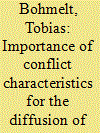

|
|
|
|
|
| Summary/Abstract |
This article argues that similar conflict characteristics form links between crises, which signal the relevant actors – that is, the belligerents and the potential mediator(s) – that a comparable approach in terms of third-party mediation could be suitable across these disputes – even if the relevant parties are not the same. Specifically, demand (antagonists) and supply-side actors (mediators) are likely to employ the heuristic of learning from and emulating the mediation behavior in similar crises. The empirical analysis, using data from the International Crisis Behavior project, shows that comparable patterns in violence, arguably the most visible and salient conflict characteristic, are associated with mediation traveling across crises; other dispute characteristics incorporated into spatial lags are not, however. Hence, particularly as domestic/unit-level (monadic) influences are controlled for, the effect of common exposure is taken into account, and different estimation strategies are used, the results emphasize that there is a genuine diffusion process via common levels of violence in the context of international mediation.
|
|
|
|
|
|
|
|
|
|
|
|
|
|
|
|
| 8 |
ID:
145701


|
|
|
|
|
| Summary/Abstract |
Bridging social ties is thought to reduce the likelihood of interethnic violence. This logic has motivated countless development projects and international programs seeking to forge cross-group ties between groups with a conflictual history. However, this article identifies an important mechanism by which certain cross-group ties can make interethnic peace strictly less likely. The results stem from a game-theoretic model which formalizes civil society as a network and relates intergroup cooperation to the particular networks that transmit information from person to person in each group. The model reveals that, first, groups are capable of enforcing cross-group cooperation, even when no cross-group ties are present and the networks within each group are missing links, using peer-enforcement strategies, and their ability to do so depends on the structure of these networks. Second, when attempting to enforce intergroup cooperation, groups with sparse networks may be at risk of a long-lasting series of back-and-forth retaliation that groups with denser networks would avoid. Finally, there exists a mechanism by which some cross-group ties make intergroup cooperation strictly less likely. When interethnic cooperation is enforced by threatening coordinated retaliation for any misbehavior, success depends on expectations about how quickly retaliation can be coordinated and how many will participate in it. Some individuals in a network are in a position to send news to many others quickly; others are not. The latter therefore coordinate retaliation more slowly and would be relatively vulnerable to cross-group defections if they could be identified. Cross-group ties expose the vulnerability and generate incentives to disrupt interethnic peace; cross-group ties between the least embedded individuals in each ethnic group are the most dangerous. Programs seeking to impose ties should avoid exposing this vulnerability without taking steps to mitigate its danger.
|
|
|
|
|
|
|
|
|
|
|
|
|
|
|
|
| 9 |
ID:
145699


|
|
|
|
|
| Summary/Abstract |
While much previous research has examined the relationship between interstate military alliances and the structure of domestic regimes, existing findings point in contradictory directions. Some have argued that democracies attract each other as alliance partners, and thereby generate international peace as a consequence of their domestic regime type, while others have argued that the causal relationship is reversed, and that international pacification creates the necessary space for international alliances and domestic democratization. To disentangle this difficult empirical relationship, this article presents an empirically grounded simulation model of the dynamic coevolution of interstate military alliances, international conflict, and domestic democratization, demonstrating a statistical approach which accounts both for the complex interdependencies generated by coevolving multiplex networks of interstate ties and for their reciprocal influence on the coevolution of domestic political regimes, over the period 1920–2000. The results show that international institutions and domestic institutions are mutually constituted, with both ‘selection’ effects and ‘influence’ effects operating simultaneously. In particular, the evidence indicates that states with similar regimes are more prone to ally with each other, mutually democratic dyads are less inclined to engage in militarized disputes, and states that form international alliances with democratic partners are more likely to develop domestic democratic institutions. Tests of out-of-sample predictive accuracy, across multidecade prediction windows, further demonstrate that the coevolutionary model consistently outperforms specifications that ignore coevolutionary effects, in predicting subsequent patterns of military alliances, military conflict, and domestic democratization.
|
|
|
|
|
|
|
|
|
|
|
|
|
|
|
|
| 10 |
ID:
145690
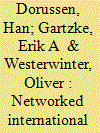

|
|
|
|
|
| Summary/Abstract |
Network theory and methods are becoming increasingly used to study the causes and consequences of conflict. Network analysis allows researchers to develop a better understanding of the causal dynamics and structural geometry of the complex web of interdependencies at work in the onset, incidence, and diffusion of conflict and peace. This issue features new theoretical and empirical research demonstrating how properly accounting for networked interdependencies has profound implications for our understanding of the processes thought to be responsible for the conflict behavior of state and non-state actors. The contributors examine the variation in networks of states and transnational actors to explain outcomes related to international conflict and peace. They highlight how networked interdependencies affect conflict and cooperation in a broad range of areas at the center of international relations scholarship. It is helpful to distinguish between three uses of networks, namely: (1) as theoretical tools, (2) as measurement tools, and (3) as inferential tools. The introduction discusses each of these uses and shows how the contributions rely on one or several of them. Next, Monte Carlo simulations are used to illustrate one of the strengths of network analysis, namely that it helps researchers avoid biased inferences when the data generating process underlying the observed data contains extradyadic interdependencies.
|
|
|
|
|
|
|
|
|
|
|
|
|
|
|
|
| 11 |
ID:
145703
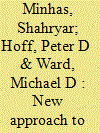

|
|
|
|
|
| Summary/Abstract |
Previous models of international conflict have suffered two shortfalls. They tend not to embody dynamic changes, focusing rather on static slices of behavior over time across a single relational dimension. These models have also been empirically evaluated in ways that assumed the independence of each country, when in reality they are searching for the interdependence among all countries. A number of approaches are available now for analyzing relational data such as international conflict in a network context and a number of these can even handle longitudinal relational data, but none are developed to the point of exploring how networks can coevolve over time. We illustrate a solution to the limitations of existing approaches and apply this novel, dynamic, network based approach to study the dependencies among the ebb and flow of daily international interactions using a newly developed, and openly available, database of events among nations.
|
|
|
|
|
|
|
|
|
|
|
|
|
|
|
|
| 12 |
ID:
145697


|
|
|
|
|
| Summary/Abstract |
Why do countries contribute troops to UN peacekeeping? Recognizing the incentives to free ride on the contributions of other countries, existing explanations have tended to focus on the private benefits of providing troops. There has been particular emphasis on some major contributing countries that gain financially from providing peacekeepers. An alternative explanation could be that countries prefer to deploy troops to peacekeeping alongside countries with similar foreign policy preferences in order to maximize jointly produced private benefits. Accordingly, the willingness to provide peacekeepers should depend on which other countries are providing troops to peacekeeping operations. The implications are explored within the context of games on networks, and it is demonstrated that in equilibrium countries that are more Bonacich central in the network of foreign policy preference contribute disproportionally to UN peacekeeping. Based on actual contributions to UN peacekeeping from 1990 until 2011, we find that policy complementarities explain why countries provide a larger proportion of peacekeepers to a particular mission. Importantly, centrality in the network of policy complementarities matters and not simply that countries have moderate policy preferences. There is robust evidence for the prevalence of peacekeeping alongside your ‘friends’; in effect, countries with a lot of ‘friends’ contribute more peacekeepers.
|
|
|
|
|
|
|
|
|
|
|
|
|
|
|
|
| 13 |
ID:
145694


|
|
|
|
|
| Summary/Abstract |
Why do states form non-aggression pacts? Non-aggression pacts are different from typical alliances because the latter tend to be focused on relationships between members of the alliance and other states, such as by deterring external threats or mediating the resolution of conflicts between an alliance member and a third-party challenger. We offer two contributions that build on existing work. First, we provide a theory that explains why leaders use non-aggression pacts as information mechanisms. Leaders of states that have recently emerged from a rivalry seek to overcome an important information asymmetry: they know the probability of future conflict among the former rivals has decreased, but other actors may fear a resumption of hostilities. Such leaders use non-aggression pacts to signal that the rivalry has truly ended and that future relations are likely to remain peaceful. Second, our analysis recognizes the often multilateral nature of the non-aggression pact formation process. We use the ‘k’-adic statistical procedure to model non-aggression pact formation as a multilateral process. To operationalize recent rivalry cessation within a group, we use a network analytic density measure. Consistent with our theory, we find that groups of states with greater densities of recently ended rivalries are significantly more likely to form non-aggression pacts. These results hold across a series of model specifications.
|
|
|
|
|
|
|
|
|
|
|
|
|
|
|
|
| 14 |
ID:
145700


|
|
|
|
|
| Summary/Abstract |
Networks of international nongovernmental organizations with missions concerning conflict resolution (CROs) conduct a number of innovative international programs designed to promote peace. Is this network of CROs effective? In this article, we argue that the CRO network can transmit information and promote norms of peace that help in reducing international conflict. Our theoretical argument builds on earlier work concerning international governmental organizations (IGOs) and peace and we examine whether and how the connections among states through CRO ties can lead to reductions in international conflict. We test the key empirical implication of our argument – concerning how the CRO network can foster peace – using new social network measures that focus on the actual network of citizens and elites connected internationally by CROs, rather than focusing on the size or presence of civil society within a state. We find considerable support for our central hypothesis that the network of international CROs is associated with peace. When a state is more embedded within the CRO network, international bellicosity from that state is diminished. This result holds at both the monadic and dyadic (non-directed and directed) levels of analysis. At the dyadic level, the CRO network works even when we account for the IGO network with a similar conflict resolution focus. At the dyadic level, we find that the greater the number of possible CRO informational channels between the states in the dyad, the less bellicosity within the dyad.
|
|
|
|
|
|
|
|
|
|
|
|
|
|
|
|
|
|
|
|
|